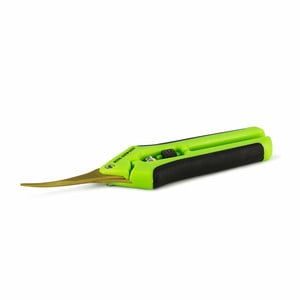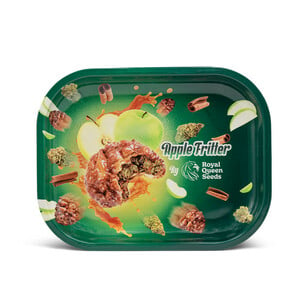 Weed Grow Guide by Royal Queen Seeds
Weed Grow Guide by Royal Queen Seeds
- Growing weed step by step
- Marijuana growing basics
- Choosing your seeds
- How to germinate seeds
- The marijuana vegetative stage
- The marijuana flowering stage
- Harvesting marijuana
- Trimming, drying, and curing
- Choosing pots and soil
-
Growing indoors
- A Complete Overview Of Growing Cannabis Indoors
- Cannabis Cultivation Tips: How To Set Up Indoor Grow Lights
- How Many Cannabis Plants Can You Grow Per Square Metre?
- Indoor Cannabis Growing: Relative Humidity and Temperatures
- Hydroponics Cannabis Growing Guide (with diagrams)
- Cannabis Micro Growing: Growing Great Weed in Tiny Spaces
- Growing outdoors
- How to grow autoflowering marijuana
- Marijuana nutrients and pH
- Marijuana troubleshooting: Nutrients
-
Marijuana troubleshooting: Growing
- Cannabis Seed Germination — Troubleshooting Guide
- How to Deal With Pythium (Root Rot) in Cannabis Plants
- Slow Cannabis Plant Growth And What You Can Do About It
- How to Prevent and Fix Stretching in Cannabis Seedlings
- Watering Your Cannabis: How to Fix Overwatering and Underwatering
- Understanding Male, Female, And Hermaphrodite Cannabis
- Identifying and Treating Common Cannabis Ailments
- How To Revive a Sick Cannabis Plant
- How to Avoid Moldy Marijuana During Drying and Curing
- How to Prevent and Treat Dry and Crispy Cannabis Leaves
- What Cannabis Leaves Can Tell You
- Causes and Solutions for Yellow Cannabis Leaves
-
Marijuana Strains Grow Report
- HulkBerry Automatic Grow Report
- Blue Cheese Auto Grow Report
- Purple Punch Automatic Grow Report
- Triple G Automatic Grow Report
- Do-Si-Dos Automatic Grow Report
- Green Gelato Automatic Grow Report
- Haze Berry Automatic Grow Report
- Purple Queen Automatic Grow Report
- Cookies Gelato Automatic Grow Report
- Sherbet Queen Automatic Grow Report
- Sweet Skunk Automatic Grow Report
- Medusa F1 Grow Report
- Marijuana plant training
-
Marijuana growing tips
- The Cannabis Plant Anatomy
- How to preserve seeds
- How Much Sunlight Do Outdoor Cannabis Plants Need To Grow?
- How to Control and Prevent Stretching in Cannabis Plants
- My Cannabis Plants Are Growing Too Tall: What Should I Do?
- Should You Worry About Purple Or Red Cannabis Stems?
- What To Do When Your Indoor Cannabis Won’t Flower
- How To Protect Your Cannabis Plants From Heat Stress
- How To Tell If Your Female Cannabis Plant Has Been Pollinated
- Growing Medical Marijuana
- Bud Washing: How to Clean Your Weed
- Understanding Cannabis Yield per Plant

Trimming Your Cannabis Buds: Wet Trimming Vs Dry Trimming
The what, when, and how of trimming cannabis.
Contents:
Most growers agree that harvest time is the most rewarding part of the growing cycle. After months of raising your seedlings into mature, bud-laden plants, you’re finally able to sample the fruits of your labor!
However, you still have work to do; you’ll need to properly prepare your flowers for drying, curing, and storage. Do it correctly, and you’ll have buds that look, taste, and smoke better. Trust us; it’s worth your time and effort.
A key step, of course, is trimming the sugar leaves off your buds after clipping branches off the plant. Remember those pristine and nugget-like buds at your local dispensary or coffeeshop? Those are the result of manicuring—another word for trimming. Moving past aesthetics, these buds will also smell better, smoke better, and stay fresher after a good trim.
Let’s dive deeper into why you should trim your harvest, and consider different techniques used to get the job done.
Why Should You Trim Cannabis Buds?
Trimming those sugar leaves off will help ensure your flowers are free of mold and excess plant material. If you need more convincing, let’s break down the main reasons to trim.
🏵️ Aesthetics
Taste, aroma, and effects are the most important aspects of cannabis. However, looks don’t fall far behind. After all, nothing feels as good as pulling pristine, manicured buds out of a stash jar. Trimming your flowers will transform them from rugged nugs into those worthy of a spot on the top shelf.
👃 Aroma
Every strain offers a unique blend of terpenes that underpin its aroma. With the sugar leaves out of the way, terpenes will be that much more front and center. Trim at the right time so you can avoid dislodging too many trichomes—the glands that produce these aromatic molecules.
💨 Smooth Smoke
Lingering sugar leaves are harsh on the lungs when smoked, and they have far less THC, so it’s best to toss them aside. Once you trim your buds, they’ll hit as smooth as the best you’ll find in the dispensary.
🦠 Cannabinoid Content
Most of the trichomes that produce cannabinoids and terpenes reside on the buds. Sugar leaves do produce trichomes, but in much fewer numbers. After trimming your buds down, the ratio of plant material to cannabinoids will be more in your favor.
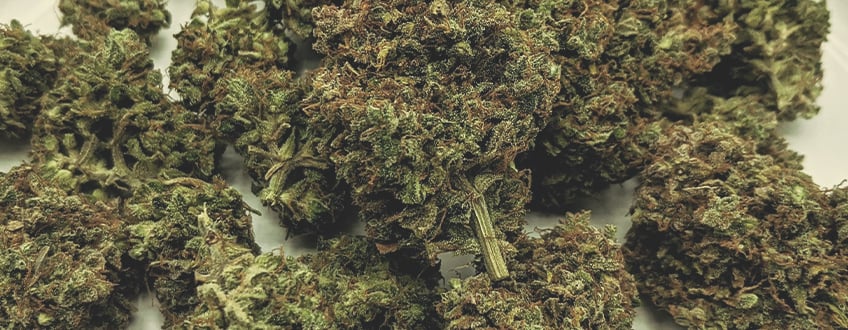
When to Trim Cannabis
Now that you know why you need to do it, you need to know how to do it right. As we mentioned earlier, timing is key when it comes to trimming cannabis flowers. For those keeping track, it’s your next port of call after harvest.
Before you even harvest, however, there are steps you can take to maximise the benefits of trimming. These steps include flushing, which, for those unfamiliar, involves cutting out nutrients and administering pure water to your plant’s growing medium before harvest. This practice encourages plants to utilise stored nutrients before harvest time, resulting in smoother and more flavorful flowers.
Most growers opt to flush their crop for around two weeks during the tail-end of the flowering stage. Proceeding to properly trim, dry, and cure your flowers will further blunt the harsh edge and enhance their aromatic properties.
Some growers prefer to trim immediately after harvesting their flowers, whereas others like to dry out their buds beforehand. Both of these techniques feature their own benefits and downfalls.
Trimming: the Best Tools for the Job
As it goes with any cannabis growing-related job, you’ll need the right tools to get it done. While they may seem simple, and in many ways are, they’re important nonetheless.
1. Curved Trimming Scissors
To start, any grower will tell you that curved trimming scissors make both harvesting and trimming so much easier. The rounded blades fit perfectly around the base of buds, allowing you to safely snip them off the branches.
They also cut flush against the natural curve of cannabis buds, allowing growers to remove sugar leaves without damaging flowers. Trimming plants can wear down your hands, though, and calluses are common. Thankfully, these scissors feature a comfortable PVC grip and spring resistance to help counter those issues.
2. Rolling Tray / Collection Tray
You’ll also want to trim your flowers over a collection tray so you can save the sugar leaves for later. If you don’t know where to start looking, our line of rolling trays feature vivid designs and raised edges that will prevent spillages and mess. You also have the option of selecting your favorite colors and sizes.
3. Suitable Stash Jar
Where do you plan on putting all of that processed bud? You can’t leave it lying around on your coffee table! You’ll need something airtight, spacious, and convenient. Our in-house brand, as it happens, has the perfect solution in the form of the RQS Re:stash Jar.
These airtight jars feature a branded silicone sleeve that keeps the internal mason jar insulated. The lid—BPA-free and crafted from renewable hemp fibre—helps to maintain freshness and optimises terpene content.
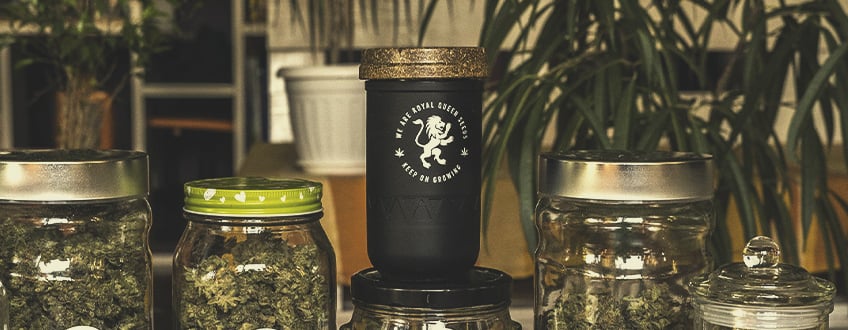
Types of Trimming
There are two ways to trim cannabis by hand: wet and dry. Alternatively, buds can be processed en masse via machine. Different growers have their own preferences, but they all end up at the same end result (if all goes well). Let’s cover the procedure and pros/cons of each method below so you can see which you prefer.
Wet Trimming

Wet trimming refers to cutting away sugar leaves immediately after harvesting your flowers. Because they still hold a lot of water, the flowers remain wet and ultra-sticky.
1. Harvest your buds
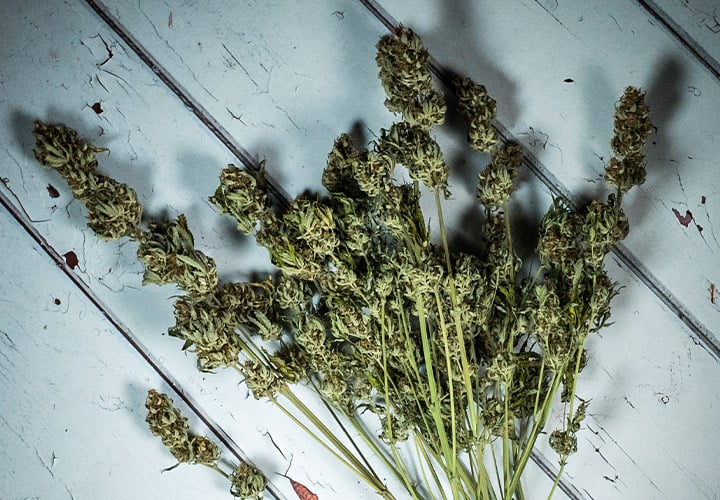
Cut each branch near the node using your curved trimming scissors. Each branch will hold several buds. Keep them attached to the branch during trimming to make your life easier. Place your bud-laden branches into a large jar or bucket until you strip the entire plant.
2. Collect your tools and prepare your hands
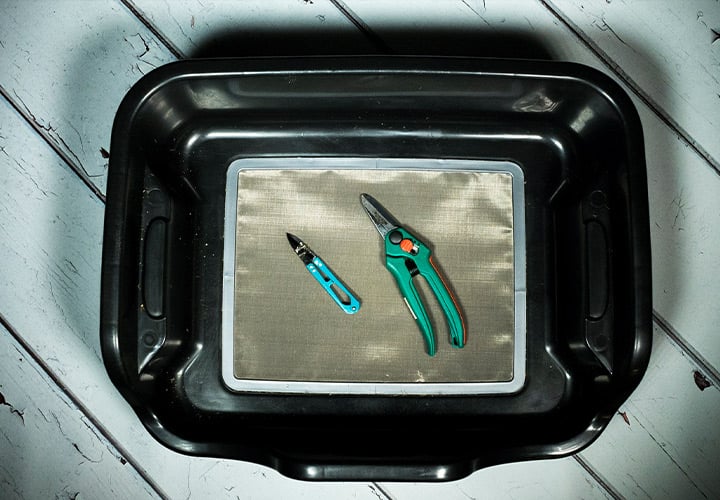
Gather your scissors and tray, turn on a podcast, and drink some coffee to help you plough through the task ahead. Wash your hands and dry them well. Then, put on a pair of latex gloves to prevent your hands from getting caked in resin.
3. Trim
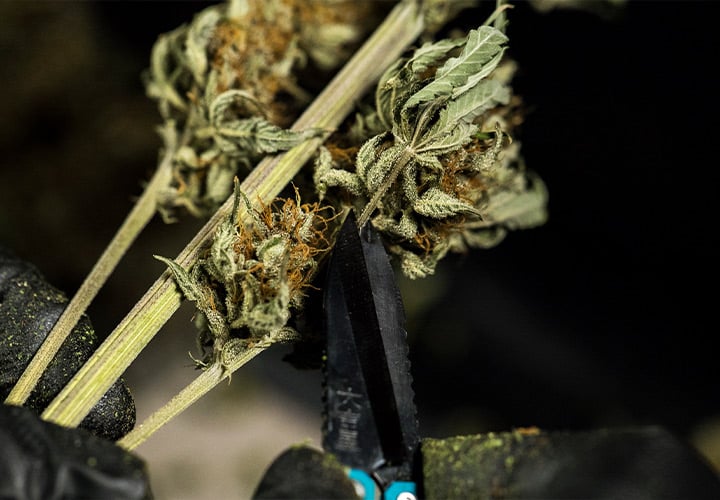
Pick up each branch, one by one, and use your curved scissors to carefully cut away all of the small sugar leaves on each bud. Many growers like to start at the base and work their way upwards in a circular fashion to ensure even, rounded edges. Some of the sugar leaves will be almost entirely concealed by the body of the bud. Remove as much as possible without damaging the flower. There will always be traces of sugar leaves left behind—don’t worry!
4. Drying and curing
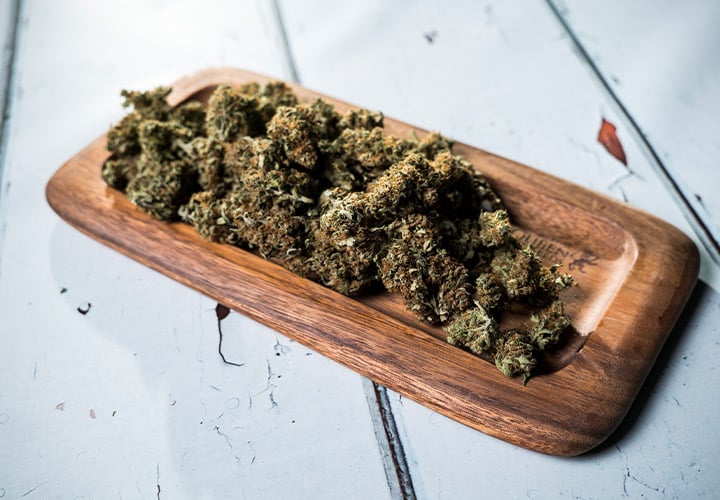
Of course, you’ll need to dry and cure your manicured buds before you blaze them up. Place them on a drying rack in a lightly heated room with a fan. Once dry, remove individual buds from their branches before placing them into jars for curing.
Dry Trimming

Dry trimming, in contrast, takes place between drying and curing. Dry buds are much less sticky, but a little more tricky to trim. Here’s how to do it.
1. Harvesting and drying
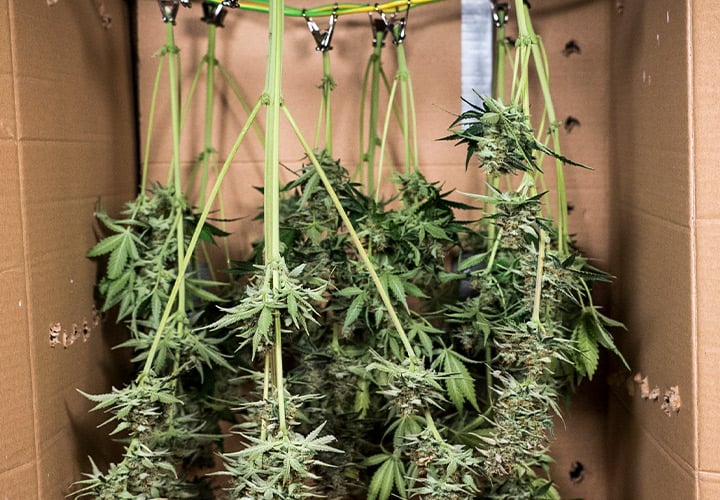
Cut your plant at the base, and hang it upside down in a warm room with a fan.
2. Processing
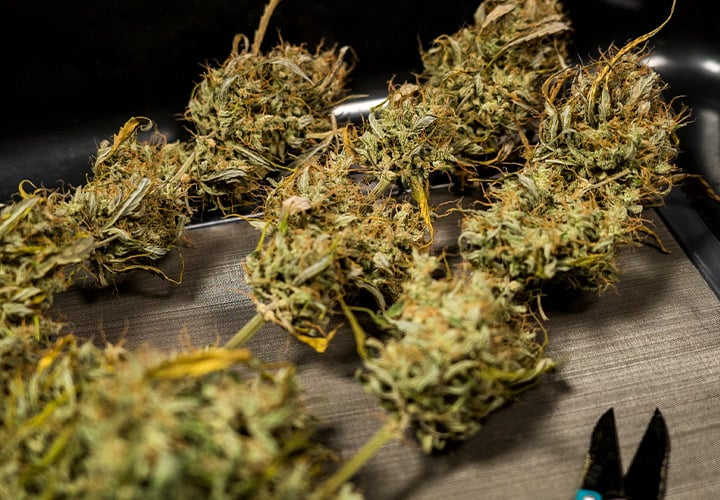
Once completely dry, cut off each individual branch and set them aside for trimming.
3. Collect your tools
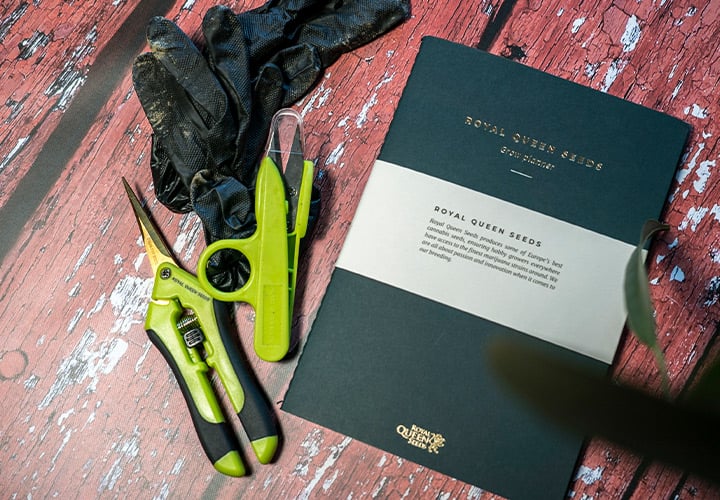
Get comfy, put on a podcast, and grab your scissors. Wash your hands and put on a pair of gloves here too.
4. Trim
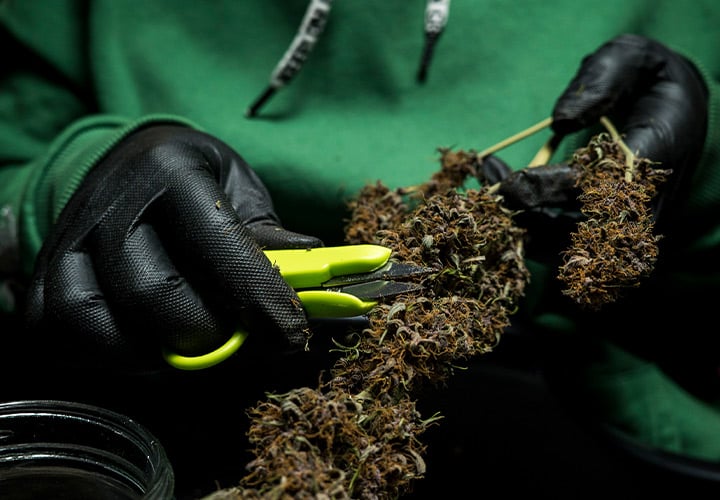
Once you’re settled, cut away all of the sugar leaves from each bud. Use your scissors to cut each bud away from the branch, one at a time. This will make them easier to cure and store.
5. Start the curing process
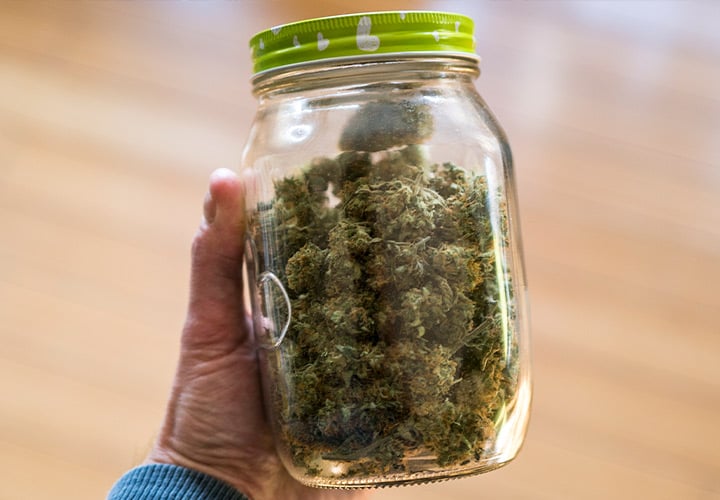
Load your buds into their curing jars for smoother hits and better flavor.
Explore the essentials of cannabis cultivation with our simple, practical growing guide!
Free RQS
Grow Guide!

Machine Trimming
Trimming by hand allows growers great attention to detail when processing their flowers. However, home growers don’t have to worry about massive volumes of flower. Commercial growers, though, view hand trimming as somewhat archaic, instead using machines to get the job done.
Trimming machines are available in many different sizes and shapes, and at different price points. Commercial-grade machines, while out of reach for average folk, can trim warehouse yields in no time. Smaller devices also exist to remove the task from the to-do list of smaller growers.
It sounds like a great hack, but there’s still a downside. Machines, unfortunately, have a reputation for damaging otherwise pristine cannabis flowers. They can save time, but you need to decide if you can tolerate the tradeoff.
Pros and Cons of Each Cannabis Trimming Method
As we’ve gone over, each of the methods above offers its own advantages and disadvantages.
| WET TRIMMING ADVANTAGES | WET TRIMMING DISADVANTAGES |
| It’s useful for preventing mold in climates with high humidity | It’s a stickier process, making it feel more tedious |
| It’s more of a linear process following harvest (with nothing between drying and curing) | The buds might dry too fast, leading to less nuance in flavor |
| The flowers dry faster without sugar leaves | The buds will be less dense and compact, which some growers don’t like |
| Growers are able to dry more buds on their drying rack | - |
| WET TRIMMING ADVANTAGES | WET TRIMMING DISADVANTAGES |
| It’s useful for preventing mold in climates with high humidity | It’s a stickier process, making it feel more tedious |
| It’s more of a linear process following harvest (with nothing between drying and curing) | The buds might dry too fast, leading to less nuance in flavor |
| The flowers dry faster without sugar leaves | The buds will be less dense and compact, which some growers don’t like |
| Growers are able to dry more buds on their drying rack | - |
| DRY TRIMMING ADVANTAGES | DRY TRIMMING DISADVANTAGES |
| It’s ideal in places with low humidity levels | Sugar leaves can store pockets of moisture, leading to mold |
| The buds become nice, compact, and nugget-like | Dry-trimmed flowers lose their initial color quite quickly |
| The flowers dry at a slower rate and maintain their full flavor | The dried sugar leaves become even smaller and harder to cut in a clean fashion |
| DRY TRIMMING ADVANTAGES | DRY TRIMMING DISADVANTAGES |
| It’s ideal in places with low humidity levels | Sugar leaves can store pockets of moisture, leading to mold |
| The buds become nice, compact, and nugget-like | Dry-trimmed flowers lose their initial color quite quickly |
| The flowers dry at a slower rate and maintain their full flavor | The dried sugar leaves become even smaller and harder to cut in a clean fashion |
| MACHINE TRIMMING ADVANTAGES | MACHINE TRIMMING DISADVANTAGES |
| It saves time compared to either hand-trimming method | There’s a risk of the machine damaging flowers |
| Smaller machines help home growers process larger yields | All that noise and gear is not ideal for stealthy growers |
| They remove one of many tasks growers are faced with | - |
| MACHINE TRIMMING ADVANTAGES | MACHINE TRIMMING DISADVANTAGES |
| It saves time compared to either hand-trimming method | There’s a risk of the machine damaging flowers |
| Smaller machines help home growers process larger yields | All that noise and gear is not ideal for stealthy growers |
| They remove one of many tasks growers are faced with | - |
What to Do With the Leftover Trim
After trimming your entire harvest, your collection tray will be filled—or overflowing—with stems, stalks, fan leaves, and sugar leaves. Although these components might seem like waste material, you can actually put this trim to good use.
No, you won’t want to smoke them, but all of these parts contain cannabinoid and terpene stores. You can use them to make all sorts of homemade products that’ll have you feeling those good herbal vibes.
Growers can get especially experimental with sugar leaves. They aren’t the best to smoke, but you can use them to make some quality cannabutter, some sugar leaf tea, or even some tasty kief to add to your bud.
Likewise, you can use the stems to make an assortment of extracts and concentrates. We believe the best uses for cannabis stems include:
• Charas
• Kief
• Bubble hash
• Tea and chai
• THC butter
• Topicals
Drying and Curing Cannabis: the Next Step
With trimming over, you’ll need to dry (unless you dry trimmed) and cure your flowers. Drying removes any excess moisture from your flowers, minimises mold formation, and makes them viable for long-term storage.
Curing your buds will greatly enhance their flavor and contribute to buttery smooth hits. The process forces buds to maintain just the right amount of moisture to make them pleasant to smoke and ideal for storing.
Check out our article on how to correctly dry and cure your harvest for more information!
 Grow Guide Topic Finder
Grow Guide Topic Finder
- Growing weed step by step
- Marijuana growing basics
- Choosing your seeds
- How to germinate seeds
- The marijuana vegetative stage
- The marijuana flowering stage
- Harvesting marijuana
- Trimming, drying, and curing
- Choosing pots and soil
-
Growing indoors
- A Complete Overview Of Growing Cannabis Indoors
- Cannabis Cultivation Tips: How To Set Up Indoor Grow Lights
- How Many Cannabis Plants Can You Grow Per Square Metre?
- Indoor Cannabis Growing: Relative Humidity and Temperatures
- Hydroponics Cannabis Growing Guide (with diagrams)
- Cannabis Micro Growing: Growing Great Weed in Tiny Spaces
- Growing outdoors
- How to grow autoflowering marijuana
- Marijuana nutrients and pH
- Marijuana troubleshooting: Nutrients
-
Marijuana troubleshooting: Growing
- Cannabis Seed Germination — Troubleshooting Guide
- How to Deal With Pythium (Root Rot) in Cannabis Plants
- Slow Cannabis Plant Growth And What You Can Do About It
- How to Prevent and Fix Stretching in Cannabis Seedlings
- Watering Your Cannabis: How to Fix Overwatering and Underwatering
- Understanding Male, Female, And Hermaphrodite Cannabis
- Identifying and Treating Common Cannabis Ailments
- How To Revive a Sick Cannabis Plant
- How to Avoid Moldy Marijuana During Drying and Curing
- How to Prevent and Treat Dry and Crispy Cannabis Leaves
- What Cannabis Leaves Can Tell You
- Causes and Solutions for Yellow Cannabis Leaves
-
Marijuana Strains Grow Report
- HulkBerry Automatic Grow Report
- Blue Cheese Auto Grow Report
- Purple Punch Automatic Grow Report
- Triple G Automatic Grow Report
- Do-Si-Dos Automatic Grow Report
- Green Gelato Automatic Grow Report
- Haze Berry Automatic Grow Report
- Purple Queen Automatic Grow Report
- Cookies Gelato Automatic Grow Report
- Sherbet Queen Automatic Grow Report
- Sweet Skunk Automatic Grow Report
- Medusa F1 Grow Report
- Marijuana plant training
-
Marijuana growing tips
- The Cannabis Plant Anatomy
- How to preserve seeds
- How Much Sunlight Do Outdoor Cannabis Plants Need To Grow?
- How to Control and Prevent Stretching in Cannabis Plants
- My Cannabis Plants Are Growing Too Tall: What Should I Do?
- Should You Worry About Purple Or Red Cannabis Stems?
- What To Do When Your Indoor Cannabis Won’t Flower
- How To Protect Your Cannabis Plants From Heat Stress
- How To Tell If Your Female Cannabis Plant Has Been Pollinated
- Growing Medical Marijuana
- Bud Washing: How to Clean Your Weed
- Understanding Cannabis Yield per Plant


























